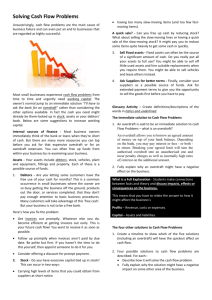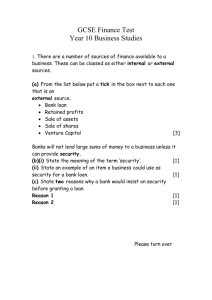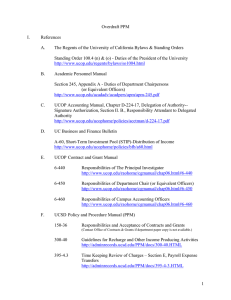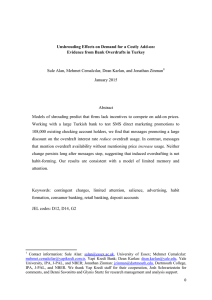Sources of Finance - Business-TES
advertisement
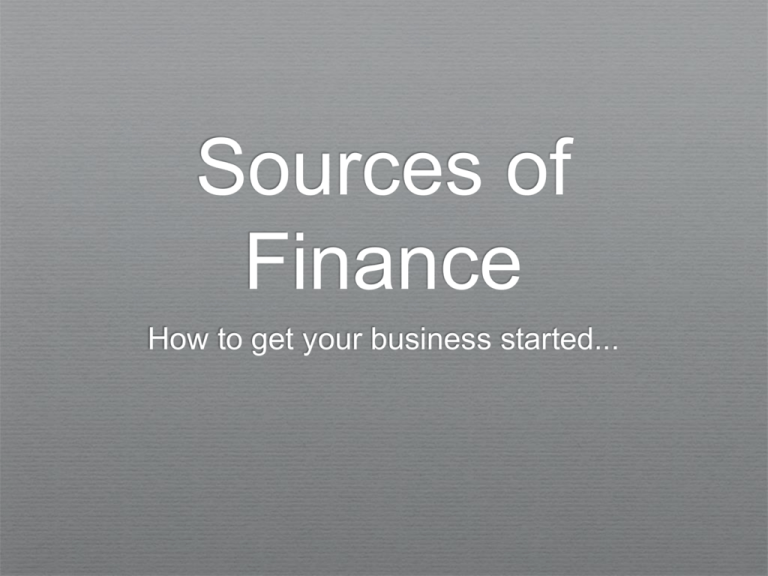
Sources of Finance How to get your business started... You have the idea... Now you need the cash.... Choosing the Right Source of Finance A business needs to assess the different types of finance based on the following criteria: Amount of money required – a large amount of money is not available through some sources and the other sources of finance may not offer enough flexibility for a smaller amount. How quickly the money is needed – the longer a business can spend trying to raise the money, normally the cheaper it is. However it may need the money very quickly (say if had to pay a big wage bill which if not paid would mean the factory would close down). The business would then have to accept a higher cost. The cheapest option available – the cost of finance is normally measured in terms of the extra money that needs to be paid to secure the initial amount – the typical cost is the interest that has to be paid on the borrowed amount. The cheapest form of money to a business comes from its trading profits. The amount of risk involved in the reason for the cash – a project which has less chance of leading to a profit is deemed more risky than one that does. Potential sources of finance (especially external sources) take this into account and may not lend money to higher risk business projects, unless there is some sort of guarantee that their money will be returned. The length of time of the requirement for finance - a good entrepreneur will judge whether the finance needed is for a long-term project or short term and therefore decide what type of finance they wish to use. Working Capital Firms need short-term finance to start up a business or to cover day-to-day running costs. This is repaid over a short period and provides a firm with working capital. Working capital The difference between current assets less current liabilities - the difference between a firm's cash and its short-term debts - the money it has to play with. Liquidity In business, the term refers to a company's ability to meet its obligations. If the firm is unable to meet its obligation in time, the company is in danger of insolvency. Therefore, heavy weight is put in finance planning by the controlling staff in order to register all potential shortages in funds. Short Term and Long Term Finance Short-term finance is needed to cover the day to day running of the business. It will be paid back in a short period of time, so less risky for lenders. Long-term finance tends to be spent on large projects that will pay back over a longer period of time. More risky so lenders tend to ask for some form of insurance or security for if the company is unable to repay the loan. A mortgage is an example of secured long-term finance. Types of short-term finance Overdraft Suppliers credit Working capital Types of long-term finance Mortgages Bank loans Share issue Debentures Retained profits Hire purchase Internal and External Finance Internal finance comes from the trading of the business. External finance comes from individuals or organizations that do not trade directly with the business e.g. banks. Examples of internal finance Internal finance tends to be the cheapest form of finance since a business does not need to pay interest on the money. However it may not be able to generate the sums of money the business is looking for, especially for larger uses of finance. Day to day cash from sales to customers. Money loaned from trade suppliers through extended credit. Reductions in the amount of stock held by the business. Disposal (sale) of any surplus assets no longer needed Examples of external finance An overdraft from the bank. A loan from a bank or building society. The sale of new shares through a share issue The Business Plan A business plan sets out how a business is going to achieve its aims and objectives. It is extremely useful for a new business to use a plan because it can be used to show potential investors how their money is going to be spent. In the plan, great care should be taken to estimate and forecast how the cash will come into and leave the business in the early weeks and months. This is because in the early days of setting up a business, finance is hardest to manage. It is uncertain how easy it will be to find customers – and will they buy the product or service at the price that is being asked? The business will be incurring significant “start-up costs” which will eat into the available funds. A business plan will probably contain the following elements Statement of aims and objectives Description of market the business is selling to Main competitors (how will they respond to a new competitor?) Production and sales forecasts Equipment needed Distribution plan for how to get product to customers Typical exam question http://www.bbc.co.uk/schools/gcsebitesize/business/finance/sourcesoffinancerev4.s html Review http://www.bbc.co.uk/schools/gcsebitesize/business/csquiz/sourcesoffinance.sht ml Worksheet answer Business plan Statement of aims and objectives Description of market the business is selling to Main competitors (how will they respond to a new competitor?) Production and sales forecasts Equipment needed Distribution plan for how to get product to customers Internal sources of finance Day to day cash from sales to customers. Money loaned from trade suppliers through extended credit. Reductions in the amount of stock held by the business. Disposal (sale) of any surplus assets no longer needed External sources of finance An overdraft from the bank. A loan from a bank or building society. The sale of new shares through a share issue Extras Working capital. Liquidity. Long term and short term finance discussion.




